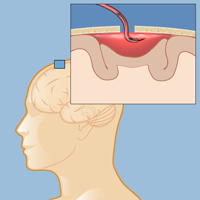An intracerebral hemorrhage (hemorrhagic stroke) is an extreme medical emergency that requires immediate treatment. A neurosurgeon with advanced training and years of experience with acute stroke and other cerebrovascular conditions will evaluate a patient to determine whether surgery is the best course of treatment. That decision will depend on the age and overall health of the patient, the degree of brain damage and neurological deficit that has already occurred, and the location and volume of the hemorrhage and hematoma.
DECOMPRESSION SURGERY relieves pressure on the brain and allows a skilled neurosurgeon to remove the pooled blood and repair damaged blood vessels. Evacuating (draining) the hematoma immediately relieves pressure on the brain by reducing the size of the pooled blood from the bleed, thereby reducing secondary damage to the brain resulting from increased intracranial pressure. A skilled neurosurgeon may choose from different surgical methods to evacuate the hematoma:
Craniotomy with open surgery
The neurosurgeon removes a portion of the skull and conducts open surgery to drain the hematoma and repair the ruptured blood vessel. This is a major surgical procedure that is typically used when the hematoma is very large, or when it’s compressing the brain stem, where critical functions are controlled.
Small craniotomy with evacuation
Recent studies suggest that performing a small craniotomy (opening a bone window in the skull that's smaller than what is typically done in a craniotomy) and using a small tube inserted into the bloot clot, through which the blood clot can be aspirated, can be very effective.
Simple aspiration
The surgeon drills a small hole (a burr hole) in the skull and drains the hematoma using a small rubber tube or catheter. This is a relatively noninvasive procedure, but it doesn’t always allow the surgeon to drain the hematoma completely. It is rarely performed.

Endoscopic evacuation is a minimally invasive surgical technique to drain a subdural hemorrhage.
Endoscopic evacuation
This is similar to simple aspiration in that it involves drilling a hole in the skull, but instead of traditional surgical instruments a highly skilled neurosurgeon can reach and drain the hematoma using an endoscope (a tiny camera-guided instrument).
Stereotactic aspiration uses computed tomography (CT) to locate the hematoma and a specially developed suction tool to drain it. The patient is immobilized in a stereotactic head frame that allows a greater degree of precision and accuracy than otherwise possible.
Clipping or coiling procedures may be appropriate if the intracerebral hemorrhage is caused by a ruptured aneurysm or AVM. In these situations multiple interventions are often required and include decompression surgery as well. (See Surgery for Aneurysms and Surgery for AVMs.)
Reviewed by: Philip E. Stieg, PhD, MD
Last reviewed/last updated: May 2024
Illustration by Thom Graves, CMI